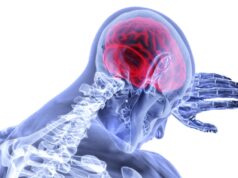
Craig Weinkauf (Tucson, USA) is leading a trial looking into a connection between Alzheimer’s disease and carotid stenosis. “We want to try to quantify the brain: volumes, structural connectivity, functional connectivity and other relevant findings associated with neurodegeneration,” he says.
Society for Vascular Surgery (SVS) member Weinkauf enrolled patient No. 1 just a few months ago in a National Institutes of Health (NIH) study to determine the impact of carotid disease on cognitive impairment and Alzheimer’s disease.
Alzheimer’s affects an estimated 5.8 million Americans and is the fifth-leading cause of death among those aged 65 years and older. It is the most common type of dementia.
Carotid disease can be slowed or reduced though lifestyle management, medication and surgical intervention. Because it is modifiable, finding a connection between carotid disease and Alzheimer’s could provide a new pathway for decreasing dementia risk, Weinkauf states.
He is leading the study, funded by a US$4.9 million NIH grant, working with a host of other experts in neuroimaging, magnetic resonance imaging, vascular disease, Alzheimer’s disease and neurocognitive function.
Carotid disease, in which vessels carrying blood to the brain become occluded, causes 10 to 20% of strokes. Weinkauf believes that many physicians might not consider it a major problem if one or two of these blood-carrying vessels are occluded because the brain still has so much collateral blood flow. The point of the study, he says, is what if this thinking is wrong?
“We are looking into this question: does carotid disease infer specific risk for Alzheimer’s disease beyond that of baseline cardiovascular risk factors?” Weinkauf continues. “We are looking beyond stroke, beyond general cardiovascular risk factors, at how blockages in the arteries that lead to your brain affect your brain health.”
Researchers started in March and will continue over the next five years to recruit roughly 240 patients, primarily in Arizona. Then, with advanced imaging, neurocognitive testing, and other specialised tests, the researchers will investigate which pathological changes specific to Alzheimer’s are associated with carotid disease; how (and if) carotid disease leads to those changes; and which treatments for carotid disease are effective at preventing or improving Alzheimer’s-associated neurodegeneration.
The team will start by determining patients’ baseline cognitive function, and what constitutes a normal decline that comes with aging.
This trial continues research from an earlier project in which Weinkauf and close collaborators tried to see if they could quantify cognitive function and changes in the brain. They quantified various aspects of cognition and brain structure, including brain volumes of the Hippocampus, the portion of the brain that supports memory—especially new memories, learning, navigation and space perception. It is also thought to perhaps play a role in Alzheimer’s disease.
The brains in Alzheimer’s patients have a “quantifiably smaller” Hippocampus, says Weinkauf. “We found the same thing in patients with severe carotid stenosis (defined as >70% stenosis) compared to well-matched controls with <50% carotid stenosis bilaterally. It is something you can quantify to see if something is changing. The project started by asking these kinds of questions.”
“We want to try to quantify the brain: volumes, structural connectivity, functional connectivity and other relevant findings associated with neurodegeneration,” he adds. “We did not have these tools 20 years ago, or even five years ago in some cases, so even if someone had thought of this then they would not have necessarily had the tools to investigate.”
“We are lucky to have surgical treatments for this problem,” he continues. “We will also be able to follow that population to see if they have key structural and functional brain changes that improve with intervention.”
Related questions are being asked in various ways by other groups as well, including the CREST-H (haemodynamics) part of the CREST-2 trial. “It is clear that these types of questions are in the air and hopefully, as a field, we will be able to improve care for our vascular patients by better understanding the connection between carotid artery stenosis and brain health,” Weinkauf says.
According to Weinkauf, some carotid patients have told him that, following a procedure for carotid disease, their vision, hearing and thinking all improved. “I think there is more overlap between these two large patient populations, those with carotid and those at risk for Alzheimer’s, than is currently appreciated,” he notes.
The research team hopes to be able to determine if baseline factors can identify those people at increased risk for Alzheimer’s and/or other forms of cognitive impairment and dementia. In a similar fashion, they will be looking to determine which baseline factors may help define who benefits from intervention. “This strategy gets at a key deficit in how we currently approach carotid disease management: there is minimal patient selection for defining subpopulations of patients with carotid disease who may benefit most from treatment,” Weinkauf adds.
“Risk-stratification of this population will be integral for honing and improving our vascular care and obtaining important objectives like personalisation of carotid vascular care. We hope that our study can help us better understand brain health in our patients and define key, quantifiable markers that help guide our surgical care.”
For more information or to learn about enrolling patients, contact Weinkauf at [email protected].
Craig Weinkauf is an assistant professor in the Department of Surgery’s division of vascular and endovascular surgery at the University of Arizona College of Medicine in Tucson, USA.













